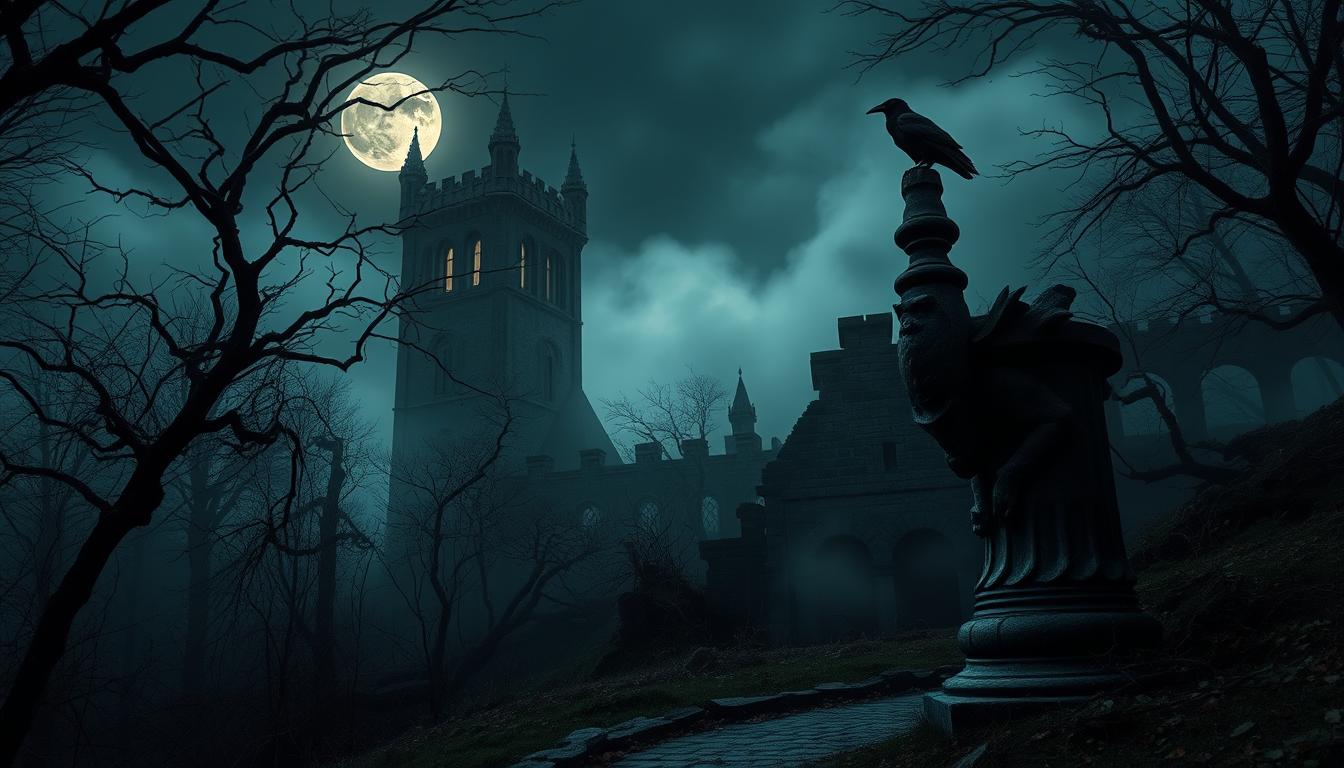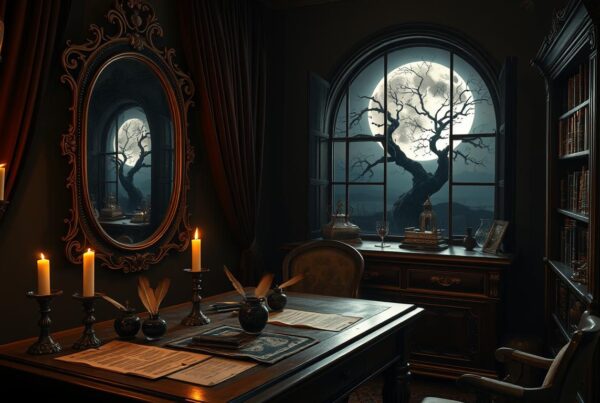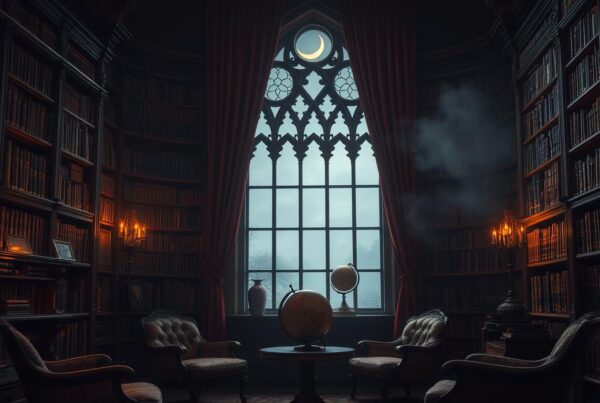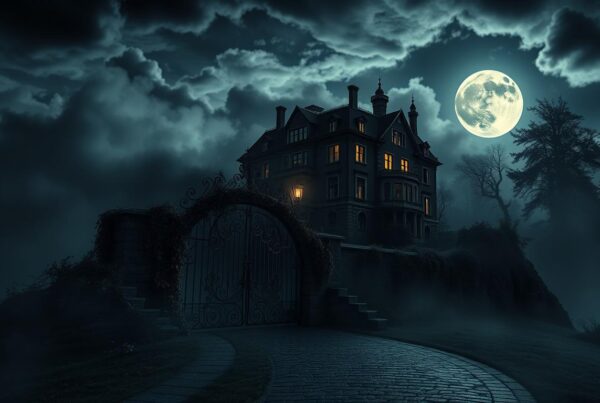Step into the shadowy world of gothic literature. Here, dark romance is king. Gothic tales take us to mysterious places filled with secrets and intrigue.
These stories grab us with their brooding heroes and heroines. They are caught in a web of passion and danger.
The charm of gothic romance is its mix of love and fear. Crumbling castles, misty moors, and candlelit corridors create a thrilling backdrop. Characters face forbidden desires and supernatural threats, offering a thrilling escape from daily life.
Gothic romance has lasted through time, evolving but keeping its core. From classic novels to modern retellings, it still captivates us. Let’s explore the haunting world of gothic literature and discover its lasting appeal.
The Origins of Gothic Romance Literature
Gothic romance started in the late 18th century. It drew readers in with mystery and passion. Horace Walpole’s “The Castle of Otranto” was the first in 1764.
This book brought in key elements of Gothic literature. These include ancient castles, supernatural events, and doomed love.
Walpole’s work started a literary movement. His story of cursed nobility and dark secrets set the stage for future Gothic romances. It inspired many writers to explore similar themes.
This led to a boom in Gothic fiction in the late 1700s and early 1800s.
The rise of Gothic romance also tied into the Romantic movement in 18th-century literature. Both genres loved emotion, nature, and the supernatural. Gothic authors mixed Romantic ideals with intense passion and wild landscapes in their stories.
Over time, Gothic romance has influenced many writers. It has shaped literary history. The impact of Walpole’s “The Castle of Otranto” is still felt today. Modern Gothic romances continue to captivate with their mix of love and fear.
Key Elements that Define Gothic Romance
Gothic romance draws you in with its dark charm and deep stories. It combines special elements for a memorable read.
Atmospheric Settings and Gloomy Landscapes
Gothic buildings set the mood. Haunted castles with high spires and long halls are perfect for spooky stories. Misty hills and thick forests make things feel isolated and full of mystery.
Complex and Tormented Characters
Tragic heroes with dark pasts fill Gothic romances. They face inner struggles, caught between love and duty. Their deep stories pull readers into their emotional battles.
Supernatural or Mysterious Events
Paranormal events are key in Gothic romance. Things like unexplained happenings, ghostly sightings, and old curses keep you guessing. These events mix reality with the unknown.
Intense Emotions and Passion
Gothic romance is all about strong feelings. Love, fear, jealousy, and desire mix in a wild way. Characters feel everything deeply, making the story exciting and intense.
These elements together make Gothic romance special. They take readers to a place where love and fear are together. It’s a journey through dark, emotional paths.
Iconic Gothic Romance Authors and Their Works
Gothic romance literature is thanks to talented writers. Ann Radcliffe, a pioneer, wrote “The Mysteries of Udolpho.” Her stories are full of suspense and vivid descriptions.
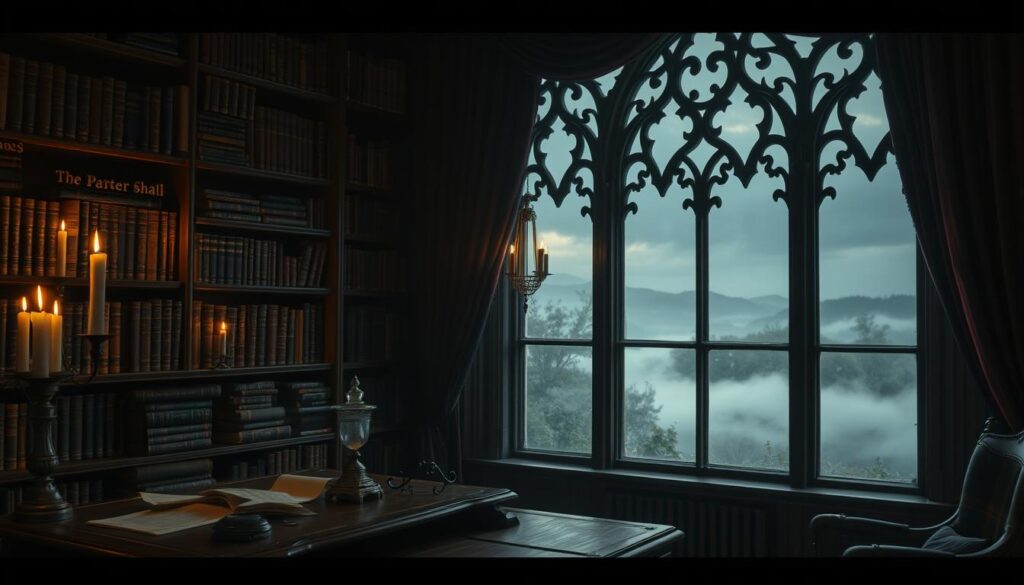
Emily Brontë’s “Wuthering Heights” is a Gothic romance classic. It’s a tale of love and revenge set in Yorkshire. Brontë’s mix of passion and darkness still inspires many.
Daphne du Maurier made Gothic romance popular in the 20th century with “Rebecca.” This thriller is set in a grand English estate. Du Maurier’s skill in creating suspense is unmatched.
These authors have left a lasting impact on Gothic romance. Their stories still captivate readers. They show the enduring charm of Gothic tales.
The Evolution of Gothic Romance Through Time
Gothic romance has changed a lot since it started. It has kept its mystery and passion but also changed with time. This change has led to new ways of telling stories that mix old Gothic themes with today’s tastes.
From Classic Gothic to Modern Interpretations
The move from old Gothic stories to new ones has seen big changes. Neo-Gothic novels came along, making old Gothic ideas new again. They keep the mystery and feel of the old stories but with new settings and characters.
Gothic Romance in Contemporary Literature
Today, Gothic romance covers many styles. Paranormal romance is very popular, mixing supernatural stories with love. Urban fantasy also uses Gothic ideas, but in cities. This mixing of styles has made Gothic stories exciting again.
Cross-genre Influences and Adaptations
Now, Gothic romance blends with other genres like science fiction and comedy. This mixing has brought new and interesting stories. Gothic romance’s lasting charm is its ability to grow and stay mysterious and passionate.
The Psychology Behind Gothic Romance’s Enduring Appeal
Gothic romance has been a favorite for centuries. It touches our deepest feelings and desires. The mix of psychological attraction and fear makes it special.
Readers love the dark, mysterious settings and complex characters. These stories offer a thrilling ride of emotions. They let us explore our darkest fantasies and face our fears safely.
Gothic romance is a way for readers to release their feelings. Through the characters, they can deal with their own emotions and worries. This makes the stories very satisfying and therapeutic.
Escapism is a big part of why people love Gothic romances. They take us to magical, often supernatural worlds. These places offer a break from our everyday lives, filled with exciting adventures and love stories.
The genre challenges our views on good and evil, love and hate. It makes us think about human nature and relationships. This makes Gothic romance a timeless and engaging read.
Gothic Romance in Popular Culture: Film and Television Adaptations
Gothic romance has been a hit on screen for years. It mixes love and fear in a way that grabs our attention. These stories have been loved for decades, with each new version bringing something special.
Classic Gothic Romance Movies
Jane Eyre movies have always been a favorite. They show the deep love between Jane and Mr. Rochester. Each movie adds its own twist to Charlotte Bronte’s classic tale.
These films often feature big houses, misty landscapes, and a strong bond between the characters.
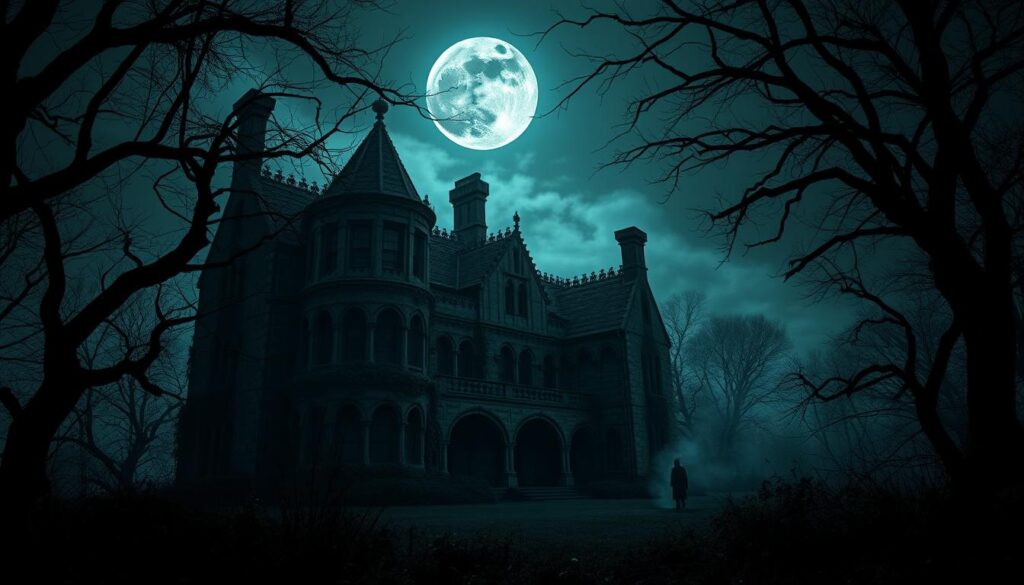
Gothic Romance TV Series and Their Impact
Recently, Gothic horror has made its way to TV. Penny Dreadful is a great example. It mixes old Gothic stories with new ones, creating a deep and spooky world.
This show shows how much people still love Gothic themes. It proves that these stories can still captivate us today.
Modern Reinterpretations of Gothic Themes
Today’s movies are finding new ways to tell Gothic romance stories. Crimson Peak, for example, is a stunning film by Guillermo del Toro. It combines horror and love in a way that’s both thrilling and beautiful.
This film, like many others, honors the old stories while also exploring new ideas. It shows how the genre can evolve and still be exciting.
Crafting the Perfect Gothic Romance: Writing Techniques
Writing a Gothic romance needs special techniques. It’s about making a world where love and fear mix well. The mood is set by vivid descriptions of dark places.
Creating characters is key. They should be complex and have secrets. This makes readers feel both sad and scared for them.
The story’s structure is important too. It should be full of mystery and surprises. Mixing love and suspense keeps readers hooked.
Using Gothic tropes adds depth to the story. Think haunted houses and family secrets. Mixing these with new ideas makes the romance exciting and fresh.
The Role of Setting in Gothic Romance: Castles, Mansions, and Moors
Gothic romance loves its setting. Castles, mansions, and moors are perfect for love and terror stories. These places are more than just scenery; they’re key characters that shape the story.
Symbolic Significance of Gothic Architecture
Gothic architecture in haunted houses is very symbolic. Spires, hidden passageways, and dark rooms show characters’ inner struggles. Old buildings show the decline of fortunes or morals.
Nature as a Character in Gothic Romance
Isolated landscapes are key in Gothic romance. Moors, forests, and seas add danger and isolation. They reflect characters’ feelings, a technique called pathetic fallacy.
Creating Atmosphere Through Description
Great Gothic writers use detailed descriptions to create atmosphere. They focus on sounds, smells, and sights. These details pull readers into the Gothic world, making it feel alive.
Love and Terror: The Interplay of Romance and Horror in Gothic Literature
Gothic literature is a mix of love and fear. It draws us in with romance and horror. This creates a world where love and dark desires meet.
At the heart of Gothic tales is suspense. Authors create complex characters facing inner struggles and tough relationships. These stories have heroes and heroines who face supernatural challenges or social rules.
Gothic romances explore the dark side of love. They touch on forbidden topics and hidden desires. This mix of love and fear gives readers a thrilling experience from their seats.
